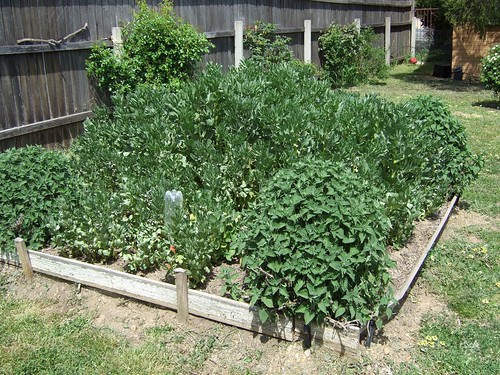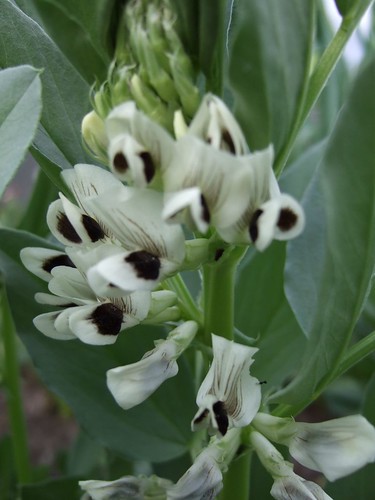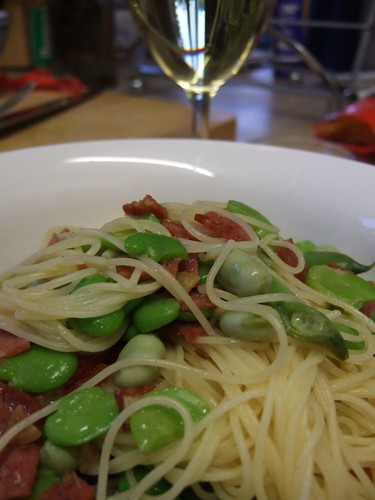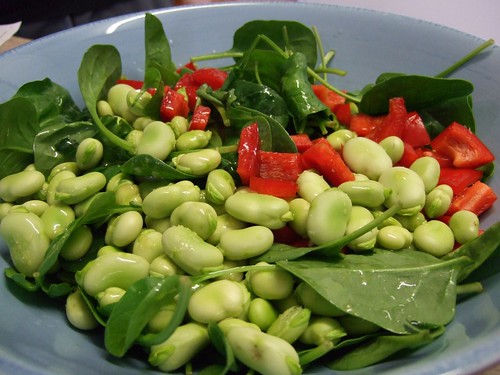I think a lot of people hate them because of how they've so often been appallingly dished up. Giant broad beans, when they're getting too big and tough for eating, are not helped at all by being boiled to death and slapped down on a plate, unadorned and ugly. Their skins become crinkled and water logged; they taste bitter. Yuck. No wonder people hate them.

We grew them because we read that they were a great way to feed the soil over winter (the roots add nitrogen) and last year, the tomatoes we grew in the former broad bean bed were the best we'd ever had. Success!
Here's how one of our beds looked over winter.

They fast became a tradition, if by tradition you mean 'we did it two years running and plan to do it again'.
Another reason to grow them is they have delightful flowers that run the length of the quite tall stalks, adding some interest to an otherwise dull winter garden.

When the pods themselves are still quite young, I find them irresistible to nibble on while I'm out and about in the yard. So tender and delicately sweet!
So, what can you do with them? My favourite recipe, cobbled together last year from a bit of research when I found myself overloaded with the pods and unsure what to do, is a pasta recipe.
This recipe requires that you double peel the beans, which means taking them out of the pods, blanching the beans for a couple of minutes, then peeling the skins off to reveal the vibrantly green insides, which are tender and sweet. They look like this.

It's kinda fiddly to double peel them, but I got into a groove with it this year and found it, as so many repetitive jobs can be, quite soothing and the results were worth it.
Saute them with garlic for a few minutes in olive oil and toss them through angel hair (or any other fine) pasta, maybe with some chopped red chillies if you like. I added some chopped salami to it this year, too. With a glass of wine, it was delicious.

When they were still quite young, the first dish I made was a thrown together salad with baby spinach, diced capsicum and cucumber. Add extra virgin olive oil, a little sea salt and some red or white wine vinegar and it's perfect! They're served raw here, obviously not something you'd do later in the season.

Over time, they went into soups, such as one that had diced zucchini, leek and, of course, the tender young broad beans in a vegetable broth. Can't beat it.
And finally, the Moroccan dip I mentioned on the weekend. If you have Stephanie Alexander's excellent Cook's Companion, you'll find the recipe there. If not, it's here. Think hummus - it's got a similar texture.

Byessar - Moroccan Broad Bean Dip
500g podded broad beans (the older, bigger ones are perfect for this - you can also use the frozen ones from the supermarket)
2 cloves garlic
1 tsp fresh oregano
1 tsp ground cumin
150ml extra virgin olive oil
Fresh ground black pepper
Garnish
1 tsp paprika
1/2 tsp chilli powder
1/s tsp ground cumin
1 tbs extra virgin olive oil
3 spring onions chopped
Boil the beans for 15 minutes, drain and reserve the cooking water.
Combine all dip ingredients, except for garnish, in a blender. Blend until smooth, adding some of the cooking water a little at a time to stop it from being so thick.
Transfer puree to a flat dish. Mix garnish ingredients and drizzle over the dip. Serve immediately.
I hope that's demystified broad beans a little, or maybe even piqued your interest in a legume you might have thought was a disgusting, tasteless item best avoided. I can't imagine my spring cooking, or my garden, without them now.
Bells


|